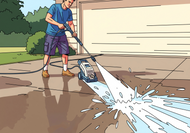Mastering Electric Pressure Washers: Best Practices and Common Mistakes
Published by Shishir on 2025 Aug 19th
Electric pressure washers are efficient and eco-friendly, but they rely heavily on stable infrastructure—specifically consistent voltage and amperage. Without proper electrical support, even high-end units can underperform or fail over time.
A commercial/industrial grade pressure washer demands a certain understanding from the operator as they are designed to offer maximum performance possible within the available voltage and amperage parameters.
Over-amperage is a leading cause of tripped breakers and motor damage, often due to improper use. Ensuring correct setup and operation helps prevent costly equipment failures.
Installation
Please take following steps while installing your pressure washer:
| Circuit Breaker | Please ensure the circuit breaker is rated higher than the pressure washer specification, and is a dedicated circuit, not being shared with other gadgets/appliances. |
| Outlet Voltage | Please measure voltage at the outlet where the unit is being installed to ensure there is no voltage drop in the lines. |
| Cable Run | If using an extension cable, please ensure you are using a cable of sufficient gauge, and less than the max recommended length. |
| Generator | It is advisable not to use a generator as it does not take well to the initial amperage spike when the pressure washer is switched on. |
Commissioning
| Start-up | All electric pressure washers observe an amperage spike when they are switched on. Please back off the unloader valve by turning the knob counter-clockwise before switching on the pressure washer, and then gradually turn the knob clockwise to build pressure. Failure to do so could trip the circuit breaker and reduce motor life considerably. If the breaker trips before the unloader valve knob reaches the maximum limit, please stop turning the knob. Turn the unloader knob counter-clockwise a little and mark that spot as the max operating condition. |
| Testing | If the unloader valve knob turns clockwise to its limit without tripping the breaker, please do not try to adjust the unloader valve settings. Once you have reached the maximum operating setting, please measure the voltage & amperage at the motor junction box/toggle switch to ensure it is under the motor’s rated amperage, and full voltage is available. If the pressure washer is run for a long time on a higher amperage, it will reduce the life of the motor. |
If you notice over- amperage even though voltage available at the motor junction box is adequate, please contact us for troubleshooting with a video of the setup under operation.
Operation
Please operate your pressure washer keeping following points in mind:
| Dedicated Line | Please ensure the power to the pressure washer is through a dedicated circuit, not being shared with other gadgets/appliances. Running other equipment like air compressors etc., even intermittently, causes voltage drop in the system and over-amperage in the pressure washer. |
| Maintain Your Pump | Please remember to change the pump oil on a regular basis (every 100 hours of operation, and/or depending on the condition of the oil). |
| Clogs | Any clogs in the system, be it clogged nozzles, gun, hose, or the unloader valve, will put additional load on the motor, causing it to draw excessive amperage, thereby tripping the circuit breaker and/or harming the motor. |
| Correct Nozzle Size | Please use nozzles of correct orifice size only, as determined based on the PSI and flow rate of your pressure washer using a nozzle chart. A nozzle with a larger orifice size will not produce the rated pressure but will not harm the pressure washer either. However, a smaller sized nozzle will create back pressure and put excessive load on the motor. |
All pressure washers will have normal wear and tear, and will require repair/replacement eventually, but following the above guidelines will help extend the life of your equipment.

